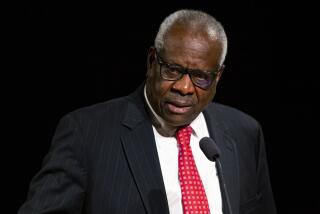PERSPECTIVE ON SCIENCE : More Than a Test-Tube Tempest : The David Baltimore case make us question what government limits should be in dealing with scientific fraud.
- Share via
The resignation of David Baltimore as president of Rockefeller University culminates a major chapter in the pursuit by Rep. John D. Dingell (D-Mich.) of scientific fraud.
Baltimore, a Nobel laureate biologist, was accused of whitewashing a case of scientific fraud when a 1986 research paper prepared under his supervision was alleged to have been supported by data fabricated by a colleague. (There was no suggestion that Baltimore himself fabricated data.)
Baltimore’s departure from the university, forced by the controversy over his handling of the affair, reinforces the impression that Dingell has indeed unearthed a serious problem. But there is a good deal of disagreement among scientists about the Baltimore case, and there is widespread concern that it could lead to serious damage to our scientific enterprise. There are also important facts about the case that have not generally reached the public. It is important to consider now where we should go from here.
There is no question that a number of scientists and administrators have erred in brushing aside whistle-blowers who made credible allegations of fraud. Dingell was justified in pressing our research institutions to strengthen their mechanisms for dealing with the problem. But to maximize his case, he gave the public the impression that science in the United States is now burdened by a crisis of integrity.
To most scientists this proposition is a large exaggeration. Since scientists have to trust each other’s data, they are harmed by fraud much more than taxpayers are. Nevertheless, from its beginnings science has occasionally encountered fraud. We do not wish to tolerate it, and we can try to minimize it. But we cannot eradicate it, and we need a balanced effort. An excessively zealous pursuit, creating an atmosphere of mistrust, will chill bold and creative approaches to science.
The strongest evidence against a crisis is the phenomenal success of biomedical research today, and the daily experience of scientists. We continue to build on our traditions of trust and autonomy in promoting excellence by example and peer review rather than by legal procedures. Our schools continue to attract enthusiastic, highly motivated graduate students and fellows. But excessive bureaucracy could discourage the brightest young people from undertaking a career in science, since much of its appeal has come from its tradition of flexibility, freedom to be as creative as an artist, and even playfulness.
Dingell, however, has clearly been convinced that science needs to be monitored in a more businesslike way. He created an unjustifiable tragedy by choosing to focus on the problematic Baltimore case, instead of several well-authenticated cases of fraud.
Its political appeal was tempting. Not only did it net such a big fish as a Nobel laureate, but an image also emerged in which an idealistic young researcher, Margot O’Toole, was allegedly ostracized from science for four years by the respected senior investigators whom she had the courage to challenge. And though this picture of martyrdom has now been found to be largely a myth, and quite unfair to the scientists who were blamed, its powerful emotional appeal has greatly distorted the discussion.
Excessive reliance on O’Toole’s sincere but often-contradicted testimony certainly contributed to the conclusion by the Office of Scientific Integrity of the National Institutes of Health that Baltimore’s collaborator, Thereza Imanishi-Kari, had committed fraud. But a number of scientists have called for suspended judgment, for several reasons. The NIH office’s procedure lacked due process; many immunologists have built reliably in the past on Imanishi-Kari’s work; and it is hard to see why she would assign O’Toole to build on work that she knew was fraudulent. Moreover, the new director of the NIH, Bernardine Healy, has courageously stood up to Dingell and challenged the handling of the case by the Office of Scientific Integrity as virtually a rogue operation.
Initially, Baltimore had wide support from scientists, because he was defending important principles. But he gradually lost support, as his courage against such a powerful adversary was increasingly seen as arrogance. The outcome has not only been a personal tragedy but one for all of science and society. Hopefully he will now be able to expand his activities as a creative scientist, and we should wish him well. But it is hard to see how we will benefit from having curtailed the future use of his talents as an administrator and statesman.
Finally, I am puzzled that scientists differ so intensely in judging whether Baltimore violated the canons of science. One factor may be a subtle difference between two kinds of science. When one works on the structure of a compound, the answer is correct or incorrect; an error must be publicly corrected. But in less mature fields, such as the cellular immunology of the disputed paper, scientists can flounder for years before the pieces fit together. Much of what is published will then turn out to have been in error, and minor errors are often allowed to die of neglect rather than clutter the literature with corrections.
The Baltimore case seems to be laying the ground for having government actively seek fraud, instead of simply supporting improved university responses. The term fraud has unfortunately been replaced by misconduct , and efforts to broaden the definition are shifting issues of morality and standards into areas of legal action.
If we wish to move on constructively from the Baltimore tragedy, we should now focus on setting proper limits for the role of government in dealing with scientific fraud.






